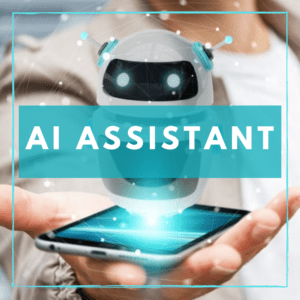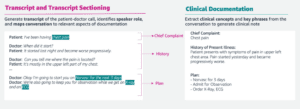Previous articles in this series introduced the role of generative AI in the healthcare back office and examined its use in billing and revenue management. We’ll cover a lot of other uses in this article.
Patient Contact and Care Management
CEO Rahul Sharma of HSBlox says that the next version of its CureAlign platform will use generative AI to help improve the care management processes in its CareTracker module.
Many patients need reminders, if not actually coaxing, to come in for appointments. The CureAlign platform personalizes outgoing communication based on past interactions with the patient. Sharma says that message generators can take language translation services and the level of education into account.
Once a patient is engaged, the care team can prepare the personalized plan and put in place device monitoring and data collection. CareTracker will help to set up a large set of nonclinical and administrative steps, including medication reminders, appointment scheduling, scheduling check-ins for telehealth appointments, creation of alerts and notifications when things do not go as planned, prescription refills, and prompting for daily exercise under the care plan.
Harman Dhawan, founder and CEO of Bikham, says that generative AI can help you generate patient notes and summaries by capturing voice and inputs in a live environment. There is a spooky aspect to this, but as doctors and patients get used to it, care can be delivered more efficiently.
Caen Contee, CEO and co-founder of Wellplaece, says, “Generative AI technologies offer unprecedented personalization in patient management by analyzing comprehensive data, including case histories and social factors. This analysis enables the creation of tailored treatment and communication plans for each patient, ensuring that their unique needs are met.”
He adds that “by allowing insurance plans and policies to be queried through natural conversation, AI creates a more engaging and understandable experience for patients. This approach demystifies the often complex language found in healthcare documents.” The user interface can be represented through avatars and video, providing 24/7 access to information.
Abhishek Sharma, principal of business transformation at Sagility, treats communications as a “transaction,” and says that email automation is “fundamental to any back-office processing.” AI can determine where each email message should go, for instance with a curated response. Moreover, he suggests extending back-office automation to case triage, where advanced LLM classifiers can precisely identify the correct routing for cases, either as a downstream process or when misroutes occur.
Trent Peterson, director of product design and head of user experience at AdvancedMD, points out, “AI is available on-demand and is never impatient. It is never distracted or preoccupied and never has something better to be doing. When done right, the user experience can be personal, flexible and intuitive.” When a patient explains their problem, a chatbot with a human-sounding voice can pose intelligent questions such “How severe is your pain? Can you describe it on a scale of one to 10?” and “Does tomorrow at 10 AM work for you?”
The AI service will finish by sending a personalized confirmation email such as, “We understand you are in a lot of pain and we have prioritized your appointment.”
Going further, Peterson expects AI agents, with access to all the patient’s clinical and financial information, to answer questions and even complete tasks on behalf of the patient. Additionally, AI is now being developed that, with permission, can “see” the user’s screen, and can take temporary control of the user’s mouse and keyboard. In health care, this might be used to show the user how to use the practice’s website and find needed information or complete an unfamiliar task.
Christine Duncan, manager, product management at AdvancedMD, says that generative AI can also assist in automating workflows that reschedule and cancel appointments and that manage waitlists. AI can also predict the probability that a patient will not show up for their appointment, or will cancel at the last minute. Going further, the AI can help explain the factors that make a missed appointment or late cancelation more or less likely. This enables front office staff to take extra steps for patients with these factors, to decrease the number of open time slots within their provider’s schedule.
Call Center Support
Imagine you are taking calls at 10:00 PM, and a person calls in to say they are experiencing chest pain. Wouldn’t it be great to have access to a senior cardiologist? How about a dozen senior cardiologists? AI can provide comparable support.
Doug Ross is vice president, US head of generative AI at Sogeti, part of Capgemini. During the next few months, they will be able to provide call centers with this kind of support, as well as administrative help, such as checking patients’ insurance coverage.
Dr. Rowland Illing, chief medical officer and director of global healthcare and non-profits at Amazon Web Services (AWS), suggests use cases for call report summarization and agent performance assessments. For example, generative AI tools could analyze a call transcript to highlight areas for improvement.
Jean-Claude Saghbini, President of the Lumeris Value-Based Care Enablement business, writes, “There are various methodologies that use existing, foundational LLMs while restricting the answers to be from prescribed data sets. An organization may have massive amounts of documentation and data that enable call center staff to search and provide answers to a member’s question. But unlike when you use the open version of ChatGPT, techniques can be employed on existing LLMs to provide direct answers to the questions asked while restricting the answer to being produced from the organization’s own data.”
Other Use Cases
In late 2023, Avanade started to offer Microsoft-based generative AI services that support admissions and discharges, which require staff to pull together a dizzying set of patient requirements and history. Avanade, a joint venture of Accenture and Microsoft, works with clients to employ Microsoft’s service.
Doug Ross is vice president, US head of generative AI at Sogeti, part of Capgemini. He says that additional back-office use cases include prescription guidance and prescription adherence. Capgemini works with several clients whose chatbots notice whether a patient has picked up their meds and then generate questions to ask why they haven’t: Are they deterred by the medication’s effects? Do they have difficulty taking the pills? These enterprises can then identify available substitutes, along with adverse interactions.
Melvin Lai, senior associate at Silicon Foundry, mentions that generative AI has many uses in pharma: “A well-designed protocol plans every level of the clinical trial, giving detailed consideration for components like design consistency, patient or site burden, and diversity and inclusion requirements. Exploiting successful prior trial protocols can be helpful in this process, but such information is buried in hundreds of pages of historical protocol documents and remains largely untapped. Generative AI can analyze this wealth of information and identify the key patterns, cost-saving opportunities, and streamlined operations to create new protocols for future clinical trials.”
WNS’s data capture and processing platform, Skense, underlies health care activities ranging from medical summarization and simplified bill review to scientific research. Skense ingests both structured and unstructured data, generates contextualized information, and creates structured datasets for business analysis and consumption by downstream applications.
According to Dr. Gauri Puri, head of healthcare and life sciences at WNS, Skense is already being used for clinical decision-making, as well many use cases discussed in this series, and others such as nurse reviews.
She writes, “Payers use AI not only to review claims history, but also to combine claims data with other reference datasets (such as lab, historical, and disease datasets) to build predictive models that forecast a member’s service consumption patterns. This is helping payers build personalized plans for every member. Pharma companies employ AI to create models using claims, research, and ‘omics’ data for precision medicine.”
Two key areas of focus, she says, will be patient/member experience and clinical support and decision-making. Finally, she warns the organizations using AI to stay abreast of evolving regulatory guidelines.
Wellplaece focuses on services for dental offices. According to Contee, they use generative AI to analyze resumes. He says, “AI systems can conduct a deep analysis to forecast the candidate’s future performance, evaluate their strengths and weaknesses, and rate them against specific job requirements.”
Priti Shah, chief product and technology officer of Iodine Software, talks of “clinical documentation integrity,” which can be found as a department in all health care systems. Iodine is used by nurses and by staff responsible for clinical documentation integrity to identify inaccuracies and prioritize which cases to review. The company has based its applications on its AI engine since its founding, and is now integrating GPT-4.
She says that an LLM can help give a better summary of what happened since the last time a physician reviewed a record. She says that AI explainability is important, providing background data to back up what the AI tool is saying.
Ryan Hamilton, chief product officer of MacroHealth, advises, “Organizations should look to AI to increase their business agility: their ability to predict, detect, and react quickly to changes in the environment.” MacroHealth talks about “intelligent health markets” and uses generative AI to improve savings and efficiency.
Nick Stepro, chief product and technology officer of Arcadia, says generative AI can aid data entry and management.
Axuall aggregates clinical data for applications that use generative AI to reduce onboarding time and solve other workforce issues. CEO Charlie Lougheed writes to me, “For AI to provide solutions that health systems can act upon, it must be provided with strong, up-to-date data. Inadequate data could lead to a flawed AI recommendation and consequently to mistrust toward the tool.”
Sirona Medical provides AI-based services for radiology, where images rather than text are the key data. According to founder and CEO Cameron Andrews, there is no follow-up for more than one-third of all incidental findings in radiology. He says, “Generative AI can parse radiology reports, identify follow-ups and critical findings, draft patient communications, and manage patient coordination and scheduling.”
Peterson says that the latest generation of LLMs have vision capabilities that allow them to extract paper-based EOB information, saving many hours of manual entry and related costs.
Strategic Solutions Group sees natural uses for generative AI in generating documents such as grant proposals.
The next article in this series will look at how to train healthcare LLMs.
Get Fresh Healthcare & IT Stories Delivered Daily
Join thousands of your healthcare & HealthIT peers who subscribe to our daily newsletter.




